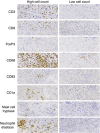Detailed analysis of inflammatory cell infiltration in colorectal cancer
- PMID: 24008661
- PMCID: PMC3790164
- DOI: 10.1038/bjc.2013.508
Detailed analysis of inflammatory cell infiltration in colorectal cancer
Abstract
Background: Higher-grade inflammatory infiltrate is a promising marker for better prognosis in colorectal cancer (CRC). However, the knowledge on the interrelationships between different inflammatory cells and classifications is fragmentary.
Methods: We analysed the densities of eight types of inflammatory cells in a prospectively recruited group of 117 CRC patients and determined their interrelationships and contributions to Klintrup-Mäkinen (K-M) score of overall peritumoural inflammation. We characterised the inflammatory infiltrate in relation to stage and recurrences in 24-month follow-up.
Results: There were high positive correlations between the inflammatory cell densities, with the exception of mast cells and CD1a+ immature dendritic cells. High K-M score associated with high peri- and intratumoural densities of CD3+, CD8+, CD68+, CD83+, and FoxP3+ cells and neutrophils. Advanced stage associated with low K-M score, as well as low CD3+, CD8+, CD83+, and FoxP3+ cell counts, of which low K-M score, low CD3(+) T-cell count, and low FoxP3+ T-cell count were linked to higher recurrence rate.
Conclusion: The density of CRC inflammatory infiltrate declines as stage advances. Especially, low K-M score and low T-cell counts predict higher recurrence rate. The high positive correlations between the individual inflammatory markers support the value of overall inflammatory reaction scoring.
Figures


References
-
- Abramoff MD, Magelhaes PJ, Ram SJ. Image processing with ImageJ. Biophotonics Int. 2004;11:36–42.
-
- Banchereau J, Briere F, Caux C, Davoust J, Lebecque S, Liu YJ, Pulendran B, Palucka K. Immunobiology of dendritic cells. Annu Rev Immunol. 2000;18:767–811. - PubMed
-
- Bates GJ, Fox SB, Han C, Leek RD, Garcia JF, Harris AL, Banham AH. Quantification of regulatory T cells enables the identification of high-risk breast cancer patients and those at risk of late relapse. J Clin Oncol. 2006;24:5373–5380. - PubMed
-
- Curiel TJ, Coukos G, Zou L, Alvarez X, Cheng P, Mottram P, Evdemon-Hogan M, Conejo-Garcia JR, Zhang L, Burow M, Zhu Y, Wei S, Kryczek I, Daniel B, Gordon A, Myers L, Lackner A, Disis ML, Knutson KL, Chen L, Zou W. Specific recruitment of regulatory T cells in ovarian carcinoma fosters immune privilege and predicts reduced survival. Nat Med. 2004;10:942–949. - PubMed
-
- Dieu-Nosjean MC, Antoine M, Danel C, Heudes D, Wislez M, Poulot V, Rabbe N, Laurans L, Tartour E, de Chaisemartin L, Lebecque S, Fridman WH, Cadranel J. Long-term survival for patients with non-small-cell lung cancer with intratumoral lymphoid structures. J Clin Oncol. 2008;26:4410–4417. - PubMed
Publication types
MeSH terms
Substances
LinkOut - more resources
Full Text Sources
Other Literature Sources
Medical
Research Materials

